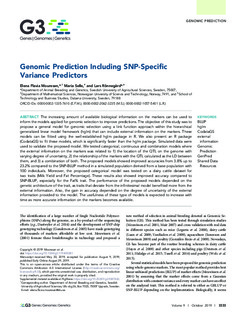| dc.contributor.author | Mouresan, Elena Flavia | |
| dc.contributor.author | Selle, Maria | |
| dc.contributor.author | Rönnegård, Lars | |
| dc.date.accessioned | 2020-02-11T07:26:42Z | |
| dc.date.available | 2020-02-11T07:26:42Z | |
| dc.date.created | 2019-10-21T13:34:44Z | |
| dc.date.issued | 2019 | |
| dc.identifier.citation | G3: Genes, Genomes, Genetics. 2019, 9 (10), 3333-3343. | nb_NO |
| dc.identifier.issn | 2160-1836 | |
| dc.identifier.uri | http://hdl.handle.net/11250/2640891 | |
| dc.description.abstract | The increasing amount of available biological information on the markers can be used to inform the models applied for genomic selection to improve predictions. The objective of this study was to propose a general model for genomic selection using a link function approach within the hierarchical generalized linear model framework (hglm) that can include external information on the markers. These models can be fitted using the well-established hglm package in R. We also present an R package (CodataGS) to fit these models, which is significantly faster than the hglm package. Simulated data were used to validate the proposed model. We tested categorical, continuous and combination models where the external information on the markers was related to 1) the location of the QTL on the genome with varying degree of uncertainty, 2) the relationship of the markers with the QTL calculated as the LD between them, and 3) a combination of both. The proposed models showed improved accuracies from 3.8% up to 23.2% compared to the SNP-BLUP method in a simulated population derived from a base population with 100 individuals. Moreover, the proposed categorical model was tested on a dairy cattle dataset for two traits (Milk Yield and Fat Percentage). These results also showed improved accuracy compared to SNP-BLUP, especially for the Fat% trait. The performance of the proposed models depended on the genetic architecture of the trait, as traits that deviate from the infinitesimal model benefited more from the external information. Also, the gain in accuracy depended on the degree of uncertainty of the external information provided to the model. The usefulness of these type of models is expected to increase with time as more accurate information on the markers becomes available. | nb_NO |
| dc.language.iso | eng | nb_NO |
| dc.publisher | The Genetics Society of America | nb_NO |
| dc.rights | Navngivelse 4.0 Internasjonal | * |
| dc.rights.uri | http://creativecommons.org/licenses/by/4.0/deed.no | * |
| dc.title | Genomic prediction including SNP-specific variance predictors | nb_NO |
| dc.type | Journal article | nb_NO |
| dc.type | Peer reviewed | nb_NO |
| dc.description.version | publishedVersion | nb_NO |
| dc.source.pagenumber | 3333-3343 | nb_NO |
| dc.source.volume | 9 | nb_NO |
| dc.source.journal | G3: Genes, Genomes, Genetics | nb_NO |
| dc.source.issue | 10 | nb_NO |
| dc.identifier.doi | 10.1534/g3.119.400381 | |
| dc.identifier.cristin | 1739060 | |
| dc.description.localcode | Open Access CC-BY | nb_NO |
| cristin.unitcode | 194,63,15,0 | |
| cristin.unitname | Institutt for matematiske fag | |
| cristin.ispublished | true | |
| cristin.fulltext | original | |
| cristin.qualitycode | 1 | |

